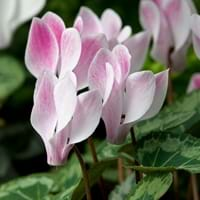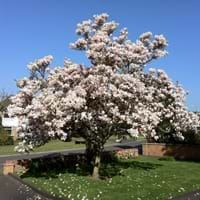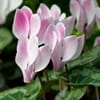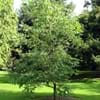Life Span
Perennial
Perennial
Type
Flowering Plants, Tubers
Tree
Origin
Europe, Mediterranean Basin, Middle East, North Africa, Somalia
Hybrid origin
Types
Cyclamen Africanum, Cyclamen Alpinum, Cyclamen Cilicium, Cyclamen Coum
Gwillimia, Manglietia, Kmeria
Habitat
Alpine Meadows, Rocky areas, Woods
Subtropical climates, Tropical regions
USDA Hardiness Zone
5-9
6-9
Sunset Zone
15, 16, 17, 18, 19, 20, 21, 22, 23, 24
Not Available
Habit
Clump-Forming
Oval or Rounded
Flower Color
Pink, Purple, White
Purple, Pink, Light Pink, Rose
Flower Color Modifier
Not Available
Bicolor
Leaf Color in Spring
Several shades of Green
Green
Leaf Color in Summer
Not Available
Green
Leaf Color in Fall
Green, Silver
Green, Yellow green, Sandy Brown
Leaf Color in Winter
Green, Silver
Not Available
Leaf Shape
Heart-shaped
Ovate
Plant Season
Autumn, Spring, Summer, Winter
Spring, Summer
Sunlight
Indirect sunlight
Full Sun, Partial Sun
Growth Rate
Medium
Medium
Type of Soil
Clay, Sandy, Well drained
Clay, Loam, Sand
The pH of Soil
Acidic
Acidic, Neutral
Soil Drainage
Well drained
Well drained
Bloom Time
Autumn, Spring, Summer
Spring, Late Spring
Tolerances
Not Available
Not Available
Where to Plant?
Container, Ground, Pot
Ground
How to Plant?
From bulbs, Seedlings
Seedlings, Transplanting
Plant Maintenance
Medium
Medium
Watering Requirements
Do not water frequently, It cannot sustain wet-feet, Keep the ground moist but not water-logged, Prefer drip-irrigation instead of Over-head watering, Water when soil is dry
Prefer drip-irrigation instead of Over-head watering
In Summer
Lots of watering
Lots of watering
In Spring
Moderate
Moderate
In Winter
Average Water
Average Water
Soil pH
Acidic
Acidic, Neutral
Soil Type
Clay, Sandy, Well drained
Clay, Loam, Sand
Soil Drainage Capacity
Well drained
Well drained
Sun Exposure
Indirect sunlight
Full Sun, Partial Sun
Pruning
Cut or pinch the stems, Prune if you want to improve plant shape, Prune ocassionally, Prune to control growth, Prune when plant is dormant, Remove dead leaves, Remove dead or diseased plant parts
Prune if you want to improve plant shape
Fertilizers
All-Purpose Liquid Fertilizer
Fertilize in late fall, fertilize in spring, Requires high amount of nitrogen
Pests and Diseases
Aphids, Botrytis Cinerea, Gray mold, Mice, Mites, Root weevil, Slugs, Snails, Squirrels
Aphids, Bacterial Blight, Canker, Crown gall, Hoplia beetle, Leaf burn, Leaf spot, Mealybugs, Powdery mildew, Red blotch, Scorch, Soft scales, Thripes, Wetwood
Plant Tolerance
Drought
Not Available
Flower Petal Number
Single
Single
Foliage Texture
Medium
Coarse
Foliage Sheen
Matte
Matte
Attracts
Not Available
Not Available
Allergy
Respiratory problems
Not Available
Aesthetic Uses
Showy Purposes
Showy Purposes
Beauty Benefits
Not Available
Treatment of Dark Spots
Environmental Uses
Air purification
Air purification
Medicinal Uses
Digestive disorders, Menstrual Disorders
Alzheimer’s Disease, Anxiety, Cancer, Digestion problems, Liver problems, Menstrual Cramps, Respiratory Disorders, Weight loss
Part of Plant Used
Root, Stem
Whole plant
Other Uses
Showy Purposes, Used as an ointment
Used as Ornamental plant, Used for its medicinal properties
Used As Indoor Plant
Yes
Yes
Used As Outdoor Plant
Yes
Yes
Garden Design
Not Available
Feature Plant, Foundation, Shade Trees
Botanical Name
Cyclamen Persicum
MAGNOLIA 'Alexandria'
Common Name
Cyclamen or Florist's Cyclamen
Alexandria Magnolia, Magnolia
In Hindi
Sikalemen
हिम चम्पा
In German
Zyklamen
Magnolienbaum
In French
Cyclamen
magnolia
In Spanish
Ciclamen
árbol de magnolia
In Greek
κυκλάμινο
Magnolia δέντρο
In Portuguese
Cíclame
magnólia
In Polish
Cyklamen
magnolia drzewa
In Latin
Cyclamīnos
Magnolia lignum
Phylum
Anthophyta
Magnoliophyta
Class
Dicotyledonae
Magnoliopsida
Order
Ericales
Magnoliales
Family
Primulaceae
Magnoliaceae
Clade
Not Available
Angiosperms, Magnoliids
Tribe
Cyclamineae
Not Available
Subfamily
Myrsinoideae
Not Available
Season and Care of Cyclamen and Magnolia Tree
Season and care of Cyclamen and Magnolia Tree is important to know. While considering everything about Cyclamen and Magnolia Tree Care, growing season is an essential factor. Cyclamen season is Autumn, Spring, Summer and Winter and Magnolia Tree season is Autumn, Spring, Summer and Winter. The type of soil for Cyclamen is Clay, Sandy, Well drained and for Magnolia Tree is Clay, Loam, Sand while the PH of soil for Cyclamen is Acidic and for Magnolia Tree is Acidic, Neutral.
Cyclamen and Magnolia Tree Physical Information
Cyclamen and Magnolia Tree physical information is very important for comparison. Cyclamen height is 0.54 cm and width 0.75 cm whereas Magnolia Tree height is 460.00 cm and width 370.00 cm. The color specification of Cyclamen and Magnolia Tree are as follows:
Cyclamen flower color: Pink, Purple and White
Cyclamen leaf color: Several shades of Green
Magnolia Tree flower color: Purple, Pink, Light Pink and Rose
- Magnolia Tree leaf color: Green
Care of Cyclamen and Magnolia Tree
Care of Cyclamen and Magnolia Tree include pruning, fertilizers, watering etc. Cyclamen pruning is done Cut or pinch the stems, Prune if you want to improve plant shape, Prune ocassionally, Prune to control growth, Prune when plant is dormant, Remove dead leaves and Remove dead or diseased plant parts and Magnolia Tree pruning is done Prune if you want to improve plant shape. In summer Cyclamen needs Lots of watering and in winter, it needs Average Water. Whereas, in summer Magnolia Tree needs Lots of watering and in winter, it needs Average Water.





